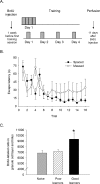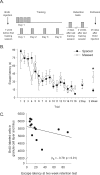Neurogenesis and the spacing effect: learning over time enhances memory and the survival of new neurons
- PMID: 17522028
- PMCID: PMC1876761
- DOI: 10.1101/lm.488707
Neurogenesis and the spacing effect: learning over time enhances memory and the survival of new neurons
Abstract
Information that is spaced over time is better remembered than the same amount of information massed together. This phenomenon, known as the spacing effect, was explored with respect to its effect on learning and neurogenesis in the adult dentate gyrus of the hippocampal formation. Because the cells are generated over time and because learning enhances their survival, we hypothesized that training with spaced trials would rescue more new neurons from death than the same number of massed trials. In the first experiment, animals trained with spaced trials in the Morris water maze outperformed animals trained with massed trials, but there was not a direct effect of trial spacing on cell survival. Rather, animals that learned well retained more cells than animals that did not learn or learned poorly. Moreover, performance during acquisition correlated with the number of cells remaining in the dentate gyrus after training. In the second experiment, the time between blocks of trials was increased. Consequently, animals trained with spaced trials performed as well as those trained with massed, but remembered the location better two weeks later. The strength of that memory correlated with the number of new cells remaining in the hippocampus. Together, these data indicate that learning, and not mere exposure to training, enhances the survival of cells that are generated 1 wk before training. They also indicate that learning over an extended period of time induces a more persistent memory, which then relates to the number of cells that reside in the hippocampus.
Figures




Similar articles
-
Hippocampus-dependent learning promotes survival of new neurons in the dentate gyrus at a specific time during cell maturation.Neuroscience. 2007 Oct 26;149(2):273-85. doi: 10.1016/j.neuroscience.2007.07.046. Epub 2007 Aug 10. Neuroscience. 2007. PMID: 17900815
-
Activation and survival of immature neurons in the dentate gyrus with spatial memory is dependent on time of exposure to spatial learning and age of cells at examination.Neurobiol Learn Mem. 2011 Mar;95(3):316-25. doi: 10.1016/j.nlm.2011.01.001. Epub 2011 Jan 7. Neurobiol Learn Mem. 2011. PMID: 21216298
-
Estradiol enhances neurogenesis in the dentate gyri of adult male meadow voles by increasing the survival of young granule neurons.Neuroscience. 2004;128(3):645-54. doi: 10.1016/j.neuroscience.2004.06.039. Neuroscience. 2004. PMID: 15381292
-
17β-Estradiol, but not estrone, increases the survival and activation of new neurons in the hippocampus in response to spatial memory in adult female rats.Horm Behav. 2013 Jan;63(1):144-57. doi: 10.1016/j.yhbeh.2012.09.011. Epub 2012 Oct 12. Horm Behav. 2013. PMID: 23063473
-
Learning enhances adult neurogenesis in the hippocampal formation.Nat Neurosci. 1999 Mar;2(3):260-5. doi: 10.1038/6365. Nat Neurosci. 1999. PMID: 10195219
Cited by
-
Effects of Testosterone and Its Major Metabolites upon Different Stages of Neuron Survival in the Dentate Gyrus of Male Rats.Biomolecules. 2025 Apr 7;15(4):542. doi: 10.3390/biom15040542. Biomolecules. 2025. PMID: 40305218 Free PMC article.
-
Genetic Depletion of BDNF Impairs Extinction Learning of a Spatial Appetitive Task in the Presence or Absence of the Acquisition Context.Front Behav Neurosci. 2021 Apr 30;15:658686. doi: 10.3389/fnbeh.2021.658686. eCollection 2021. Front Behav Neurosci. 2021. PMID: 33994970 Free PMC article.
-
Learning to learn: theta oscillations predict new learning, which enhances related learning and neurogenesis.PLoS One. 2012;7(2):e31375. doi: 10.1371/journal.pone.0031375. Epub 2012 Feb 10. PLoS One. 2012. PMID: 22348078 Free PMC article.
-
Hippocampal Mechanisms Underlying Impairment in Spatial Learning Long After Establishment of Noise-Induced Hearing Loss in CBA Mice.Front Syst Neurosci. 2018 Jul 24;12:35. doi: 10.3389/fnsys.2018.00035. eCollection 2018. Front Syst Neurosci. 2018. PMID: 30087600 Free PMC article.
-
Selective Inactivation of Fibroblast Growth Factor 22 (FGF22) in CA3 Pyramidal Neurons Impairs Local Synaptogenesis and Affective Behavior Without Affecting Dentate Neurogenesis.Front Synaptic Neurosci. 2017 Dec 19;9:17. doi: 10.3389/fnsyn.2017.00017. eCollection 2017. Front Synaptic Neurosci. 2017. PMID: 29311892 Free PMC article.
References
-
- Ambrogini P., Orsini L., Mancini C., Ferri P., Ciaroni S., Cuppini R. Learning may reduce neurogenesis in adult rat dentate gyrus. Neurosci. Lett. 2004;359:13–16. - PubMed
-
- Brown J.P., Couillard-Despres S., Cooper-Kuhn C.M., Winkler J., Aigner L., Kuhn H.G. Transient expression of doublecortin during adult neurogenesis. J. Comp. Neurol. 2003;467:1–10. - PubMed
-
- Cameron H.A., McKay R.D. Adult neurogenesis produces a large pool of new granule cells in the dentate gyrus. J. Comp. Neurol. 2001;435:406–417. - PubMed
-
- Commins S., Cunningham L., Harvey D., Walsh D. Massed but not spaced training impairs spatial memory. Behav. Brain Res. 2003;139:215–223. - PubMed
Publication types
MeSH terms
Grants and funding
LinkOut - more resources
Full Text Sources
Medical
